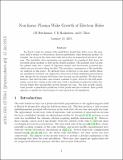| dc.contributor.author | Hutchinson, Ian Horner | |
| dc.contributor.author | Haakonsen, Christian Bernt | |
| dc.contributor.author | Zhou, Chuteng | |
| dc.date.accessioned | 2016-10-28T16:05:30Z | |
| dc.date.available | 2016-10-28T16:05:30Z | |
| dc.date.issued | 2015-03 | |
| dc.date.submitted | 2015-01 | |
| dc.identifier.issn | 1070-664X | |
| dc.identifier.issn | 1089-7674 | |
| dc.identifier.uri | http://hdl.handle.net/1721.1/105129 | |
| dc.description.abstract | An object's wake in a plasma with small Debye length that drifts across the magnetic field is subject to electrostatic electron instabilities. Such situations include, for example, the moon in the solar wind and probes in magnetized laboratory plasmas. The instability drive mechanism can equivalently be considered drift down the potential-energy gradient or drift up the density-gradient. The gradients arise because the plasma wake has a region of depressed density and electrostatic potential into which ions are attracted along the field. The non-linear consequences of the instability are analysed in this paper. At physical ratios of electron to ion mass, neither linear nor quasilinear treatment can explain the observation of large-amplitude perturbations that disrupt the ion streams well before they become ion-ion unstable. We show here, however, that electron holes, once formed, continue to grow, driven by the drift mechanism, and if they remain in the wake may reach a maximum non-linearly stable size, beyond which their uncontrolled growth disrupts the ions. The hole growth calculations provide a quantitative prediction of hole profile and size evolution. Hole growth appears to explain the observations of recent particle-in-cell simulations. | en_US |
| dc.description.sponsorship | National Science Foundation (U.S.) (Basic Plasma Science Partnership under Grant No. DE-SC0010491) | en_US |
| dc.description.sponsorship | United States. Department of Energy. (Basic Plasma Science Partnership under Grant No. DE-SC0010491) | en_US |
| dc.language.iso | en_US | |
| dc.publisher | American Institute of Physics (AIP) | en_US |
| dc.relation.isversionof | http://dx.doi.org/10.1063/1.4915526 | en_US |
| dc.rights | Creative Commons Attribution-Noncommercial-Share Alike | en_US |
| dc.rights.uri | http://creativecommons.org/licenses/by-nc-sa/4.0/ | en_US |
| dc.source | arXiv | en_US |
| dc.title | Non-linear plasma wake growth of electron holes | en_US |
| dc.type | Article | en_US |
| dc.identifier.citation | Hutchinson, I. H., C. B. Haakonsen, and C. Zhou. “Non-Linear Plasma Wake Growth of Electron Holes.” Physics of Plasmas vol. 22, no. 3, 32312, 2015, pp. 1-13. | en_US |
| dc.contributor.department | Massachusetts Institute of Technology. Department of Nuclear Science and Engineering | en_US |
| dc.contributor.department | Massachusetts Institute of Technology. Plasma Science and Fusion Center | en_US |
| dc.contributor.mitauthor | Hutchinson, Ian Horner | |
| dc.contributor.mitauthor | Haakonsen, Christian Bernt | |
| dc.contributor.mitauthor | Zhou, Chuteng | |
| dc.relation.journal | Physics of Plasmas | en_US |
| dc.eprint.version | Original manuscript | en_US |
| dc.type.uri | http://purl.org/eprint/type/JournalArticle | en_US |
| eprint.status | http://purl.org/eprint/status/NonPeerReviewed | en_US |
| dspace.orderedauthors | Hutchinson, I. H.; Haakonsen, C. B.; Zhou, C. | en_US |
| dspace.embargo.terms | N | en_US |
| dc.identifier.orcid | https://orcid.org/0000-0002-8899-7479 | |
| dc.identifier.orcid | https://orcid.org/0000-0003-3796-7357 | |
| mit.license | OPEN_ACCESS_POLICY | en_US |
